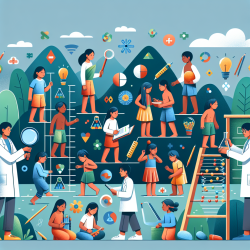Introduction
In the realm of primary healthcare, the wellbeing of Indigenous children and youth is a crucial area that demands attention and culturally appropriate assessment tools. A recent systematic scoping review titled "Counting what counts: a systematic scoping review of instruments used in primary healthcare services to measure the wellbeing of Indigenous children and youth" sheds light on the current landscape of measurement instruments used in Canada, Australia, New Zealand, and the United States (CANZUS countries). This review highlights the need for culturally relevant tools that accurately capture the unique dimensions of Indigenous youth wellbeing.
The Need for Culturally Relevant Tools
The review identifies a significant gap in the availability of measurement instruments that are specifically designed for Indigenous youth. Out of 14 instruments assessed, only four were developed with Indigenous populations in mind. This underscores the necessity for tools that reflect Indigenous perspectives, incorporating relational and strengths-based constructs that align with Indigenous worldviews.
Key Characteristics of Effective Measurement Instruments
The review outlines five critical characteristics that should be considered when selecting measurement instruments for Indigenous youth:
- Development for Indigenous Youth: Instruments should be specifically designed for Indigenous populations to ensure cultural relevance and accuracy.
- Relational and Strengths-Based Constructs: Tools should focus on positive aspects of wellbeing, encompassing individual, collective, cultural, and spiritual domains.
- Self-Administration: Allowing Indigenous children and youth to self-report ensures that their voices are heard and respected.
- Reliability and Validity: Instruments must be reliable and valid for the target population to ensure accurate assessments.
- Utility for Identifying Wellbeing or Risk Levels: Tools should effectively identify changes in wellbeing or potential risks, guiding appropriate interventions.
Implications for Practitioners
For practitioners working with Indigenous youth, it is imperative to select measurement instruments that align with the cultural context and values of the communities they serve. By doing so, practitioners can foster trust and engagement, leading to more accurate assessments and better outcomes for Indigenous youth. Furthermore, practitioners are encouraged to advocate for the development and validation of new tools that are culturally appropriate and reflective of Indigenous perspectives.
Conclusion
As we strive to improve the wellbeing of Indigenous youth, it is essential to prioritize the use of culturally relevant measurement instruments. By embracing tools that reflect Indigenous perspectives and strengths, practitioners can contribute to more effective and meaningful assessments, ultimately enhancing the quality of care provided to Indigenous youth.
To read the original research paper, please follow this link: Counting what counts: a systematic scoping review of instruments used in primary healthcare services to measure the wellbeing of Indigenous children and youth.










